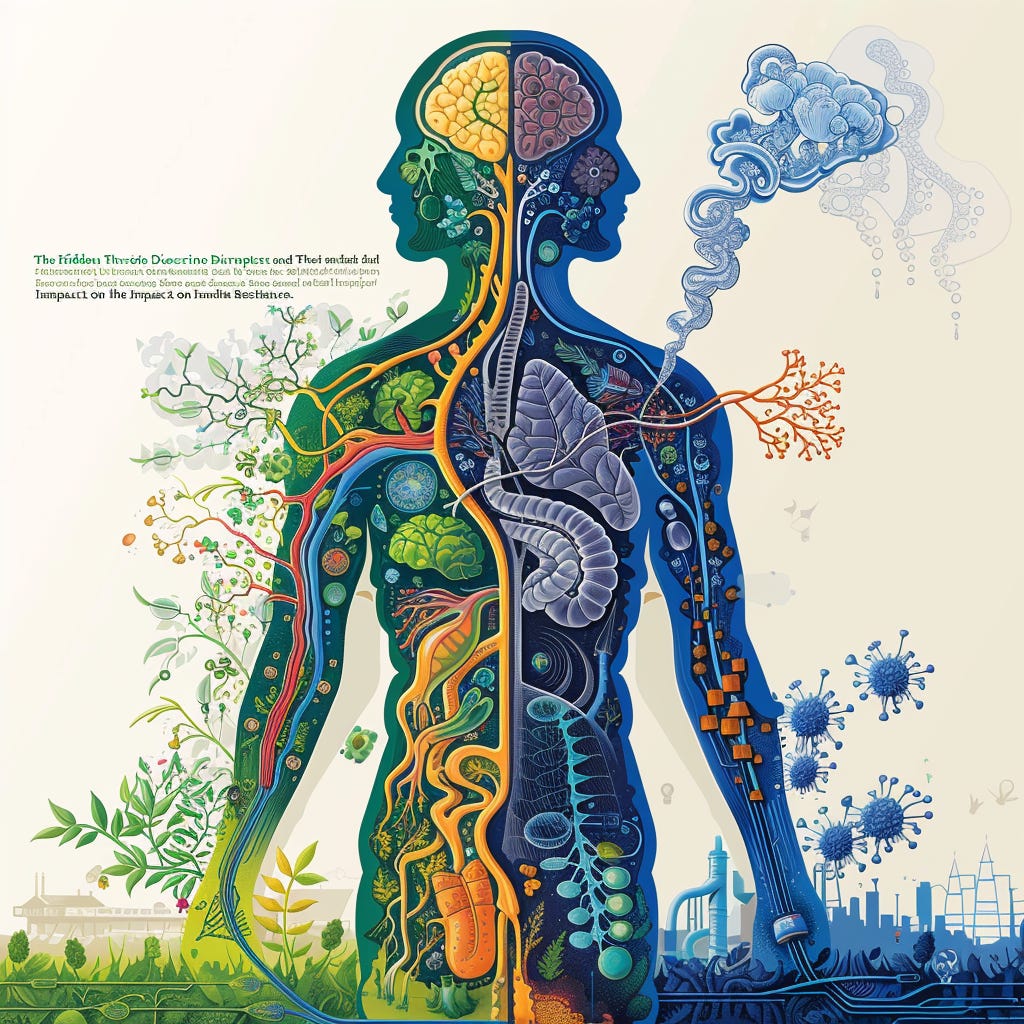The Toxic Weight Gain Link: Beyond Diet and Exercise
What’s making Americans fat goes beyond willpower and the hand-fork feedback loop of any one individual- over 70% of Americans are overweight or obese. The cumulative effects of a broken industrial food system, a broken sick care system, and widespread information chaos have resulted in a fatter, sicker, and economically untenable nation. While these statements sound awful and pessimistic in tone, there is still hope.
More and more research is emerging, bringing the health-depleting impact of toxins on our bodies into greater focus. No lie, delving into this rabbit hole is enough to make anyone want to close their eyes as if watching a classic 1970s horror film and wait until all the screams for help subside. But that’s not my style, and if you are still reading this, I doubt it is yours. Instead, we can take this information, which has been growing in the body of medical research for over a decade, and apply some powerful lessons to learn how all of it impacts the’ medicine of you.’
In my journey as a doctor and a patient navigating my health crisis, I have understood three fundamental principles: (1) You are designed to be healthy, (2) You are designed to heal, (3) You are designed to be in alignment with your environment. These three principles reflect our essence. Understanding the ‘medicine of you’ is meant to empower all of you to create a vital health plan. Here is the simple formula: a vital health plan equals health span plus life span.
It is a simple formula made difficult by the complexities of modern-day living. In this post, let’s unpack the complexities of weight loss and toxins.
One of the most fundamental concepts I learned in medical school was about pharmacokinetics and volume of distribution. The late great Dr. Charlie Puglia taught me fat-soluble compounds have a much broader volume of distribution than water-soluble compounds. Fat-soluble compounds, like some medications and toxins, can disseminate more broadly into human tissue and get pulled out of the blood stream quicker. Moreover, compounds with a high volume of distribution take much longer to purge from the body. In plain English, fat cells are the perfect warehouse for many medications and toxins, which can be problematic.
Human Canaries
You’ve heard of the ‘canary in the coal mine’ expression. It is an expression we associate with a looming danger. The idea is that some, more than others, are exquisitely susceptible to a toxic environment and begin to exhibit symptoms sooner than others. Obesity trends may very well be the human equivalent of the canary in the coal mine. Are we obese because we overeat, or do we overeat because we are obese and loaded with hormone-altering toxins?
Adipose cells, also known as fat cells, become an ideal warehouse for toxins in our bodies. Fat cells packed with toxins become like a superfund site housed within our bodies, allowing the slow, steady leaching of chemicals into a once pristine water supply. Toxin-laden fat cells gradually release toxins, disrupting the mechanisms of your central nervous system that control appetite, glucose metabolism, and sex hormones. This dynamic is quite common, and I have struggled with it for the better part of my life. Understanding how it works and showing up is half the battle, as the old GI Joe cartoon espoused.
Understanding Toxins and Their Impact on Your Weight
Toxins, Obesity and Metabolic Health
Studies indicate nearly 90% percent of Americans are metabolically unhealthy, and some even have a condition known as metabolic syndrome. A syndrome is a collection of symptoms and signs associated with a specific health-related issue that may not have a pinpointed cause. In contrast, a disease often has a known cause, pathology, and symptoms. Metabolic syndrome is a cluster of conditions—increased blood pressure, high blood sugar, excess body fat around the waist, and abnormal cholesterol or triglyceride levels—that occur together, increasing your risk of heart disease, stroke, and type 2 diabetes. These interconnected conditions are related to insulin resistance, where the body's cells do not respond effectively to insulin, disrupting normal metabolic processes.
Toxins such as bisphenols, PFAS, phthalates, PAH, arsenic, and mercury have been associated with an increased likelihood of obesity. In general, even small exposures in utero set in place a cascade of metabolic disturbances that follow a person from infancy to adulthood. Although direct cause and effect are difficult to delineate, some studies in Europe report a significant probability of having caused over 40,000 cases of childhood obesity.
Given the relatively lower regulatory oversight of chemical use in the USA compared to Europe, the trend is likely worse amongst children in the USA. Although 1 in 5 children in the US are obese overall, the rates are double in black and Latino children.
Toxins and insulin
A pivotal study, "The Hidden Threat: Endocrine Disruptors and Their Impact on Insulin Resistance," published on PMC, has illuminated this complex interaction and illustrated the extensive implications of environmental toxins on metabolic health.
Endocrine Disrupting Chemicals (EDCs), encompassing a broad range of substances from polycyclic aromatic hydrocarbons and pesticides to heavy metals, are at the forefront of this research. These chemicals, pervasive in our environment, have been shown to interfere with the endocrine system's normal function, which plays a critical role in regulating metabolism and insulin sensitivity. The article highlights explicitly the link between exposure to these toxins and the rising global health issues of type 2 diabetes mellitus (T2DM), insulin resistance, hypertension, and obesity. Such findings underscore the urgent need to reevaluate public health policies and consumer awareness regarding the potential risks associated with these environmental pollutants.
The significance of this research cannot be overstated. It deepens our understanding of the biological mechanisms behind insulin resistance and prompts a call to action for mitigating exposure to these harmful substances. As we navigate through an increasingly chemical-laden world, the study serves as a crucial reminder of the environmental determinants of health and the pressing need to address them in our fight against metabolic diseases.
Delving deeper into the mechanics behind the unsettling link between environmental toxins and insulin resistance, the "The Hidden Threat: Endocrine Disruptors and Their Impact on Insulin Resistance" article provides a comprehensive understanding of how endocrine-disrupting chemicals (EDCs) can precipitate metabolic disruptions. These mechanisms of action, backed by scientific inquiry, unravel the complexity of EDCs' impact on human health.
Mechanisms of Action:
1. Disruption of Insulin Signaling Pathways:
EDCs, including bisphenol A (BPA) and phthalates, have been implicated in distorting insulin signaling pathways. BPA, for example, binds to estrogen receptors, altering insulin action and fostering insulin resistance in target tissues. Similarly, phthalates down-regulate genes essential for insulin receptor signaling, such as Insr and Irs1, leading to systemic resistance to insulin. Additionally, dioxins, exemplified by TCDD, interact with the aryl hydrocarbon receptor, curtailing glucose uptake and further inducing insulin resistance.
2. Impairment of Pancreatic Beta-Cell Function:
Environmental pollutants have been shown to impair pancreatic beta cells' functionality directly. This impairment manifests through a reduced capacity for insulin production, a critical factor in maintaining blood glucose levels. The mechanism involves the closure of ATP-sensitive potassium channels by toxins, which induces beta-cell depolarization, thereby impeding insulin secretion.
3. Induction of Oxidative Stress and Mitochondrial Dysfunction:
Exposure to environmental pollutants has been linked to oxidative stress and mitochondrial dysfunction in adipose tissue, contributing to the development of insulin resistance. This oxidative stress disrupts normal cellular function and insulin signaling pathways, exacerbating metabolic health issues.
4. Disruption of Adiponectin and Glucose Metabolism:
EDCs may also interfere with the function of adiponectin, an insulin-sensitizing hormone, thus hindering normal glucose metabolism and promoting insulin resistance. The alteration in adiponectin's activity underscores the multifaceted impact of EDCs on metabolic health.
These insights into the mechanisms by which environmental toxins contribute to insulin resistance and metabolic disorders highlight the issue's complexity and underscore the pressing need for targeted public health interventions and policies to mitigate exposure to these harmful chemicals.
How Toxins Disrupt Metabolism and Promote Fat Storage
Toxins and Leptin
A critical hormone in this discussion is leptin, known for regulating hunger and maintaining energy balance. Recent studies illuminate how EDCs may exacerbate obesity by impacting leptin signaling pathways. First, let’s review how leptin works in the body.
Leptin Resistance and Obesity: A Vicious Cycle
Leptin, often called the "satiety hormone," is central to managing appetite and energy expenditure. Fat cells produce it and signal the brain to regulate food intake. However, leptin resistance, where the brain fails to respond to leptin's cues effectively, undermines this balance. This condition is analogous to insulin resistance in type 2 diabetes, where the body's cells do not respond appropriately despite high insulin levels. Leptin resistance is characterized by diminished feelings of satiety, leading to increased food intake and, subsequently, weight gain. Studies suggest this resistance is a significant driver of obesity, impeding the body's natural mechanisms for weight regulation.
The Critical Role of Leptin in Energy Homeostasis
Leptin's primary function is communicating the body's energy status to the brain balancing food intake with energy expenditure. However, when leptin levels fall, such as after a period of weight loss, the resulting intense hunger can often lead to weight regain. This feedback loop presents a considerable challenge for sustainable weight loss, highlighting the importance of understanding and potentially mitigating leptin resistance.
Mechanisms Underpinning Leptin Resistance
Leptin resistance arises from various factors, including inflammation, increased free fatty acids, and, paradoxically, elevated leptin levels. These elements, often exacerbated by existing obesity, create a feedback loop where weight gain promotes further leptin resistance, complicating efforts to lose weight.
The Role of EDCs in Leptin Disruption
Understanding how EDCs affect leptin function and signaling is crucial in addressing obesity and metabolic disorders.
Direct Binding and Modulation of Leptin Receptors
EDCs may mimic natural leptin receptor ligands, allowing them to bind directly to leptin receptors. This can activate or inhibit the receptors, disrupting leptin signaling pathways. Such interference can significantly alter the body's capacity to manage hunger, metabolism, and energy balance.
Interference with Leptin Synthesis and Secretion
The process by which leptin is produced and released from fat tissue is vital for energy regulation. EDCs can disrupt this process, resulting in abnormal leptin levels. This disruption can compromise leptin's ability to regulate appetite and metabolic functions, potentially leading to weight gain and obesity.
Disruption of Leptin Signaling Pathways
Leptin signaling involves downstream pathways like PI3K and STAT3, which are essential for leptin's effects on its target tissues and cells. EDCs' interference with these pathways contributes to leptin resistance, where the body fails to respond adequately. This resistance plays a significant role in the onset of metabolic disorders.
Modulation of Leptin's Interactions with Other Hormones
Leptin's interaction with other hormones, like thyroid hormones, is crucial for energy balance. EDCs can disturb this hormonal interplay, indirectly impacting leptin signaling and leading to changes in energy management and appetite.
Alteration of Leptin's Immuno-modulatory Functions
Beyond its metabolic roles, leptin is integral in regulating immune responses. EDC exposure can affect these functions, altering leptin's ability to regulate immune cell activities. This may contribute to inflammation, highlighting the broader health impacts of EDCs beyond metabolism.
This body of evidence reveals a complex attack by EDCs on the leptin system, highlighting the intricacy of EDCs' impact on health.
Gut microbiome and Weight Loss
Toxins, Gut Microbiome, and GLP-1
The gut microbiome, consisting of trillions of microorganisms, plays a pivotal role in our overall wellness, influencing everything from digestion and immunity to mental health. However, exposure to various toxins has been shown to disrupt this delicate ecosystem, with potential long-term health implications.
Heavy Metals and the Gut Microbiome
Studies have revealed that heavy metals like lead (Pb), cadmium (Cd), arsenic (As), and mercury (Hg) can significantly disrupt the composition and diversity of the gut microbiome. These metals can reduce microbial diversity and shifts in the abundance of specific bacterial strains, influencing the gut's overall microbial community structure. For instance, exposure to arsenic has been linked to alterations in the abundance of bacteria associated with inflammatory bowel disease.
Pesticides, Herbicides, and Gut Health
Similarly, pesticides and herbicides, including diazinon and glyphosate-based herbicides (GBH), disturb the gut microbiome's development and composition. These chemicals can induce dysbiosis, a harmful imbalance in the gut microbial community, which may contribute to various health issues.
The Role of Endocrine-Disrupting Chemicals
Endocrine-disrupting chemicals (EDCs), prevalent in many consumer products, can also interfere with the gut microbiome and its critical interactions with the host. EDCs may alter gut microbial community structure and metabolic functions, potentially impacting host health and disease susceptibility.
Microbial Metabolites as Toxins
Interestingly, the gut microbiome itself can produce metabolites that act as toxins, such as trimethylamine N-oxide (TMAO) and lipopolysaccharides (LPS). These compounds have been associated with the development of cardiovascular diseases, highlighting the complex role of the microbiome in health and disease.
Mechanisms of Toxin-Induced Alterations
Toxins impact the gut microbiome through direct toxicity, disruption of microbial signaling, alteration of metabolic pathways, and modulation of host-microbiome interactions. These interactions can lead to significant shifts in the microbial community and its functions, potentially impacting your health.
Impact on GLP-1 Production
One particularly noteworthy aspect of gut microbiome disruption is its impact on the endogenous production of glucagon-like peptide-1 (GLP-1). GLP-1 is a hormone involved in regulating insulin secretion and blood sugar levels. Alterations in the gut microbiome can influence the production of GLP-1, potentially affecting metabolic health and the risk of developing metabolic disorders.
Environmental toxins' disruption of the gut microbiome poses significant risks to your health. Understanding these effects and their underlying mechanisms is critical for developing strategies to mitigate toxin exposure and protect the microbiome's integrity, ultimately safeguarding your health.
Detox Your Way to Better Health and Weight Loss
Addressing the toxin problem in our bodies is a critical step towards reclaiming our health. By understanding the role of fat cells in storing toxins and the impact of environmental toxins on our metabolic health, we can unravel the complex web of factors contributing to obesity. Detoxification, through dietary changes and lifestyle adjustments, offers a path forward.
The Role of Diet and Lifestyle in Detoxification
A vital component of any detoxification effort involves examining and modifying our diets and lifestyles to support our body's natural detox processes. Consuming a diet rich in antioxidants, fibers, and clean water can aid in flushing out toxins while engaging in regular physical activity, which supports the body's systems in naturally eliminating these substances.
Understanding the Impact of Environmental Toxins
Environmental toxins are a personal health issue and a public health crisis that demands collective action. By advocating for stricter regulations on toxic substances and supporting sustainable agriculture and products, we can help reduce the overall burden of toxins in our environment and our bodies.
Ready to take control of your health and tackle the unseen obstacle of toxins in your weight loss journey? It all starts with controlling inflammation in your body.
Ready to assess how toxins impact your weight loss?
By confronting the role of toxins in obesity, we can begin to crack the weight loss code. It's not just about you; it's about our world and how we choose to interact with it. Let's embark on this journey together with knowledge and a commitment to healthier living.
References
This compilation of sources offers a broad perspective on the intricate connections between environmental toxins and key health aspects such as insulin resistance, leptin signaling, and the gut microbiome's integrity. Each reference provides valuable insights into the mechanisms through which toxins impact metabolic health, obesity, and the delicate balance within our gut ecosystem.
Environmental Toxins and Metabolic Health:
The Hidden Threat: Endocrine Disruptors and Their Impact on Insulin Resistance - An in-depth look at how endocrine disruptors influence insulin resistance, available on ResearchGate.
Endocrine-Disrupting Chemicals and Insulin Resistance - A study detailing the effects of EDCs on insulin resistance, accessible via PMC.
How Environmental Toxins Impact Metabolic Health - Insights into the broader effects of environmental toxins on metabolic health, featured on the Levels Health Blog.
Environmental Toxins and Diabetes - Research on the link between environmental toxins and diabetes, published in e-DMJ.
Impact of Environmental Pollutants on Pancreatic Beta-Cell Function - A detailed article on how pollutants affect pancreatic beta-cell function, available on ScienceDirect.
Additional studies on the impact of toxins on insulin and metabolic health include:
Leptin's Role in Obesity and Metabolic Health:
Understanding Leptin and Its Physiological Roles - A scientific exploration of leptin, provided by PubMed.
Detailed Information on Leptin - Comprehensive details on the hormone leptin, from Your Hormones.
Leptin and Body Weight Regulation - An overview of leptin's importance in body weight management, courtesy of the Cleveland Clinic.
Leptin 101: A Guide to the Satiety Hormone - An accessible guide to understanding leptin and leptin resistance, available on Healthline.
Research on Endocrine Disruptors and Hormonal Balance - Insightful research on how endocrine disruptors affect hormonal balance, found in the Journal of Molecular Endocrinology.
These references underscore the complex interplay between environmental toxins and the hormonal and metabolic processes crucial for maintaining human health.
Dr. Hector Caraballo, MD, is a physician who gained invaluable insights into the art of healing and medicine through his own life-changing health crisis. In today's fast-paced world, Dr. Caraballo emphasizes the importance of mastering 'The Medicine of You', an approach that invites individuals to become data-driven about their health markers that can impact both lifespan and healthspan. Through his writing, he aims to empower people to take control of their health before a significant crisis occurs, using his own experience as a gift to help others navigate the complexities of health and well-being.
Dr. Caraballo is the founder of Vital Essence Medica, an online medical consultation service leveraging regenerative, personalized, and functional medicine. He also serves as the Medical Director of IV Essence in San Antonio, Texas.







